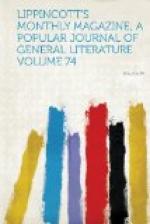The cinchonas under favorable circumstances become large trees: at present, however, in any of the explored and exploited regions of their growth, the shoots or suckers of the plants are all that remain. Wherever they abound they form the handsomest foliage of the forest. The leaves are lanceolate, glossy and vividly green, traversed by rich crimson veins: the flowers hang in clustering pellicles, like lilacs, of deep rose-color, and fill the vicinity with rich perfume. Nineteen varieties of cinchonae have been established by Doctor Weddell. The cascarilleros of South America divide the species into a category of colors, according to the tinge of the bark: there are yellow, red, orange, violet, gray and white cinchonas. The yellow, among which figure the Cinchona calisaya, lancifolia, condaminea, micrantha, pubescens, etc., are placed in the first rank: the red, orange and gray are less esteemed. This arrangement is in proportion to the abundance of the alkaloid quinine, now used in medicine instead of the bark itself.
The specimens found by the examinador were carefully wrapped in blankets, and the march was resumed. After a slippery descent of the side of Huaynapata and the passage of a considerable number of babbling streams—each of which gave new occasion for the colonel to show his ingenuity in getting over dry shod, and so sparing his threatening rheumatism—the cry of “Sausipata!” was uttered by Pepe Garcia. Two neat mud cabins, each provided with a door furnished with the unusual luxury of a wooden latch, marked the plantation of Sausipata. The situation was level, and within the enclosing walls




